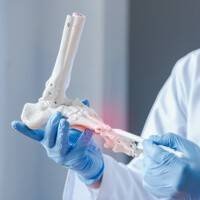A new generation of artificial joints and insertions is bringing relief to sufferers of painful hand conditions caused by repetitive strain and sports injuries.
Around 14 per cent of Hong Kong’s population suffers from pain related to problems with their hands.
These conditions are more common in women and in those over the age of 50. Patients with painful hands claim to have a poorer quality of life1 which affects their day to day activities.
Manual workers and individuals whose work involves repetitive movements can also develop arthritis in their hands. Experts also believe that over-use of new technology such as smart phones and keyboards has a role in increasing a person’s risk of developing painful joints in their hands later in life.
Rule of thumb
The thumb joint is the most commonly affected part of the hand, especially the thumb on the dominant hand. This joint is particularly susceptible to problems because of the physical stresses placed on it every day. For the patient, a problematic thumb joint can make gripping heavy objects or even just turning the key in a stiff door lock a painful process.
In many cases, the pain is a result of damage caused by stress on the ligaments in the thumb joint which in time causes the joint to slip – a condition called subluxation. The joint becomes arthritic which leads to squaring at the base of thumb at the wrist.
Traditional treatment with anti-inflammatory and steroid injections has played a small role in modifying symptoms. However, this treatment does not cure the underlying condition.
The French connection
In the last few years, exciting developments have taken place in the field of hand surgery which offer new hope of pain relief for suffers. Surgeons in France have developed a system of artificial joints using pyrocarbon technology. Similar in strength to human bone, pyrocarbon ball bearings can be used to substitute seized-up arthritic joints in the upper limbs. They provide a smooth gliding surface between the bone ends which has been shown to restore pain-free movement.
In patients with arthritic wrist joints, a pyrocarbon ball placed upon a titanium stem inserted in one of the wrist bones can restore smooth forearm rotation movements.
Sports trivia
Finger dislocations are often viewed as trivial sports injuries. They commonly occur during basketball, rugby, soccer, wrestling, and judo. The resulting ligament tears associated with this injury are often ignored and, as a result, worsen over time to cause loosening of the joints (laxity) and deformity.
One such case involved a basketball player who sustained a dislocation of his ring finger. This was treated simply by strapping his finger. However, over the next four years he noted his finger joint “loosening”, until he was unable to use his hand. Traditional treatment would have involved fusing the damaged joint.
Fortunately, a new line of finger joint implants has been developed in Japan which is able to help restore hand movements.
These implants are like miniature knee replacements which can correct the alignment of the deformed joint and provide a normal range of pain free movements. The basketball player mentioned earlier underwent ligament reconstruction with one of these new finger joint replacements and, as a result, his normal hand function was restored.
Likewise, the treatment of fractures has been revolutionized with miniature plates and tiny screws that are the size of those used for wrist watches. By stabilizing the fractures early, patients can use the hand straight away and avoid unnecessary stiffness associated with the immobilization that comes with the traditional treatment of encasing fractures in plaster.






















